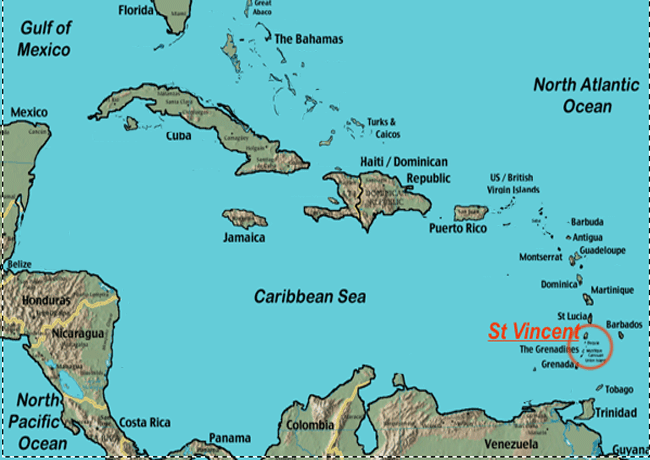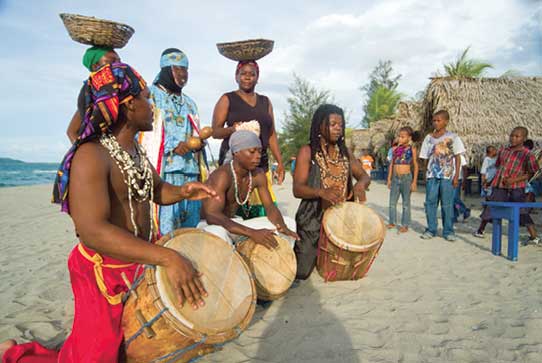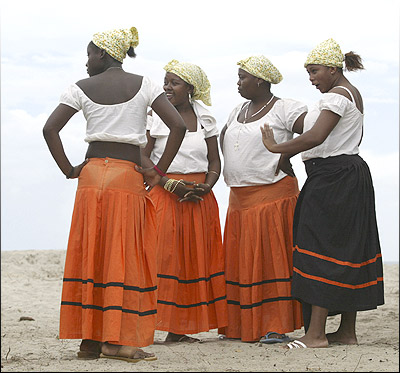While the origins of the Garifuna, a culturally hybrid, multilingual people of mixed Amerindian and African ancestry who never submitted to slavery, are not entirely clear, their Arawak-speaking Amerindian ancestors almost certainly came from tropical forests in South America. Debate persists as to whether Caribs and Arawaks constitute two separate ethnic groups, as some ethnohistorians believe New World Europeans simply grouped native peoples by whether they were hostile or friendly. Nevertheless, if Arawaks and Caribs were distinct cultures, it is highly likely that the ancestors of the Garifuna were a mixture of both.
The few native peoples to elude English or Spanish enslavement on Caribbean plantations occasionally raided European plantations, often carrying off African slaves. Other African bondsmen ran away to the sanctuaries of the free Amerindian islanders. In 1635 Spanish ships carrying kidnapped West Africans shipwrecked near the Eastern Caribbean island of St. Vincent, which, along with the island of Dominica, was an early center of Carib resistance to European rule. Survivors took refuge among the indigenous Carib people, who welcomed the newly liberated slaves into their communities. Over the decades, the West African transplants and local Amerindians intermarried and formed a hybrid culture, and in time became a distinct people known as Garifuna. Culturally the Garifuna retain their Arawak language and Amerindian patterns of subsistence, political organization, and kinship, while their African ancestry has deeply informed their oral tradition, dance, drum styles, and agriculture.
Owing to their ancestry from runaway African slaves, the Garifuna were viewed by some Europeans as an impediment to the institution of slavery and the further development of Caribbean colonization. Sporadic violence between Garifuna and English settlers in the Caribbean intensified toward the close of the eighteenth century, finally culminating in an extensive British military campaign against the Garifuna on St. Vincent in 1795. Outgunned and facing starvation, the Garifuna surrendered in late 1796 and early 1797, and were first exiled by the British to the island of Baliceaux, where roughly half of the Garifuna died as a result of unsanitary conditions and disease. In March 1797 the remaining Garifuna were transported from Baliceaux to the island of Roatán, in the Bay Islands off the Caribbean coast of Honduras. Shortly following, the Spanish seized control of the island and brought the Garifuna to the Honduran port of Trujillo, where they established thriving farms and quickly settled the shoreline from Nicaragua to Belize.
The few native peoples to elude English or Spanish enslavement on Caribbean plantations occasionally raided European plantations, often carrying off African slaves. Other African bondsmen ran away to the sanctuaries of the free Amerindian islanders. In 1635 Spanish ships carrying kidnapped West Africans shipwrecked near the Eastern Caribbean island of St. Vincent, which, along with the island of Dominica, was an early center of Carib resistance to European rule. Survivors took refuge among the indigenous Carib people, who welcomed the newly liberated slaves into their communities. Over the decades, the West African transplants and local Amerindians intermarried and formed a hybrid culture, and in time became a distinct people known as Garifuna. Culturally the Garifuna retain their Arawak language and Amerindian patterns of subsistence, political organization, and kinship, while their African ancestry has deeply informed their oral tradition, dance, drum styles, and agriculture.
Owing to their ancestry from runaway African slaves, the Garifuna were viewed by some Europeans as an impediment to the institution of slavery and the further development of Caribbean colonization. Sporadic violence between Garifuna and English settlers in the Caribbean intensified toward the close of the eighteenth century, finally culminating in an extensive British military campaign against the Garifuna on St. Vincent in 1795. Outgunned and facing starvation, the Garifuna surrendered in late 1796 and early 1797, and were first exiled by the British to the island of Baliceaux, where roughly half of the Garifuna died as a result of unsanitary conditions and disease. In March 1797 the remaining Garifuna were transported from Baliceaux to the island of Roatán, in the Bay Islands off the Caribbean coast of Honduras. Shortly following, the Spanish seized control of the island and brought the Garifuna to the Honduran port of Trujillo, where they established thriving farms and quickly settled the shoreline from Nicaragua to Belize.
The Garifuna retained clear West African elements in their music, which combines powerful vocals with a dense percussive base. The intensely percussive, communal antiphonic (call-and-response) qualities of Garifuna singing and drumming are rooted in the sacred context of ancestral invocations and spirit possession and reveal a kinship with other musical expressions of the African diaspora, especially Cuban santería, Haitian vodoun and Brazilian candomblé. Garifuna song texts serve as a repository of the history and traditional knowledge of the Garifuna, including fishing, agricultural experience, i.e. cassava-growing, and the construction of canoes and baked mud houses. Traditional Garifuna songs contain a significant amount of satire, and are accompanied by various drums and dances, which encourage communal participation. In acknowledgment of the modern threats to survival of the Garifuna culture by the lack of economic prospects, urbanization, migration, discriminatory land measures, and the school system's failure to acknowledge the language and culture, UNESCO declared Garifuna language, dance and music to be a Masterpiece of the Oral and Intangible Heritage of Humanity in 2001.
Garifuna music builds on an ensemble of two or perhaps three hollow log garaon drums: the improvising primera, which is a tenor drum considered to be the heartbeat of Garifuna music ensembles, the counter-rhythmic segunda drum that acts to shadow the primera, and the tercera that maintains a steady bass-line.
Originally music and dance developed by the Garifuna people for funeral rites, traditional punta instrumentation includes hand drums, maracas, a tortoise shell and the caracol (conch shell), and includes call-and-response singing. More recently, punta has become modernized into a popular style played by electronic instruments.
Another popular form of Garifuna music is paranda, which adds the guitar to the garaon drum ensemble. Spanish for "carousal," the salacious paranda male-female couple dance recalls the sensual motions of the Cuban rumba guaguanco.
Bibliography
Bibliography
Andrews, G.R., 2004. Afro-Latin America, 1800-2000, Oxford University Press, USA.
Gates Jr., H.L. & Appiah, K.A., 1999. Africana: The Encyclopedia of the African and African American Experience, Basic Civitas Books; 1st edition.
Louisiana’s Division of the Arts, 2009. Garifuna Music and Dance. Available at: http://www.louisianafolklife.org/LT/Articles_Essays/garifuna2.html [Accessed November 25, 2011].



Very interesting piece of history.
ReplyDelete